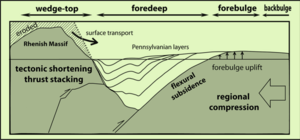Forebulge
In geology, a forebulge is a flexural bulge in front as a result of a load on the lithosphere, often caused by tectonic interactions and glaciations.
[1] Forebulge is most commonly found with continent-continent convergent collisions, in which the formation of mountain ranges as the plates collide places a large load on the lithosphere below.
[4] Collisional and retroarc thrust belts form in collision convergent plates whereas retreating collisional forms when the subduction rate exceeds the convergence rate of the collision.The Persian Gulf foreland basin and forebulge was created as a result of the collision of the Arabian and Eurasian plates around 13 million years ago.
[5] The Zagros mountains that formed, as a result, created a load on the lithosphere that led to the creation of the modern-day Persian Gulf.
Forebulge collapse due to post-glacial rebound is greatest along the east coast of the United States, which lay just under the North American ice sheet.




